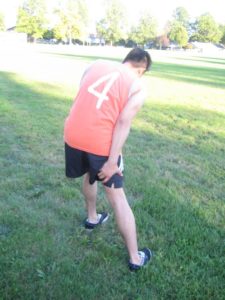Fact Checked
Meralgia paresthetica is a condition that results to pain, numbness and burning sensation in the outer area of the thigh. It happens due to excessive damage to one of the nerves in the leg.
Symptoms of meralgia paresthetica
- The symptoms can be mild at first and eventually the pain becomes severe when the condition worsen
- Sensitivity to mild touch rather than to a firm pressure
- Sensitivity to heat
- Pain, numbness, tingling and burning sensation can be felt on the outer side of the thigh.
Causes

- Spasms of muscle
- Scoliosis
- Presence of scar tissue near the inguinal ligament, due to injury during surgery
- Postsurgical complications after hip or lower back surgery
- Compression of the lateral femoral cutaneous nerves on the pelvis, groin and the thighs.
- Swelling, trauma and excessive pressure on the affected area
- Wearing tight clothing
- Overweight and obesity
- Pregnancy
- Injury such as trauma from a seat belt during vehicular accidents
- Conditions such as diabetes that can damage the nerves, alcoholism and lead poisoning.
- Standing or walking for long periods of time
- Repetitive movements that cause irritation on the nerves such as certain movements of the leg such as biking, squatting and walking.
Risk factors
- Pregnancy where a growing belly puts extra pressure on the groin and compresses the lateral femoral cutaneous nerve.
- Diabetes related nerve injury
- Being overweight or obese
- People between ages 30-60 are at a high risk of developing this condition
Treatment
- Take the prescribed tricyclic antidepressant medications to lessen the pain.
- Corticosteroid injection to lessen the inflammation and relieve of the pain.
- Take the prescribed anti-seizure medications to lessen the symptoms
- Apply cold compress on the affected area for at least 10-15 minutes to lessen the swelling and the pain. It also lessens the itchiness and the burning sensations. Avoid ice directly on the skin. Wrap ice compress using a towel or a piece of cloth before placing to the area to prevent ice burn and worsen the condition.
- Apply heat on the area in the form of hot water bottle and heat packs. Apply heat for at least 10-15 minutes to lessen the stiffness and spasms of the muscles.
- Take the prescribed pain medications such as acetaminophen, naproxen or ibuprofen to lessen the pain.
- Reduce some weight if overweight
- Wear loose-fitting clothes especially around the upper front hip area.
- Seek the help of the physical therapist for some rehabilitation exercises to strengthen the muscles of the legs. It helps relieve nerve entrapment.
- Avoid walking or standing for long periods of time.
Tips
- Take vitamin B12 supplements to lessen the burning and the tingling sensation. Increase consumption of meat, eggs and poultry products.
- Perform exercises regularly.
- Take a break especially with long periods of walking, standing, cycling and other activities that result to pain.
